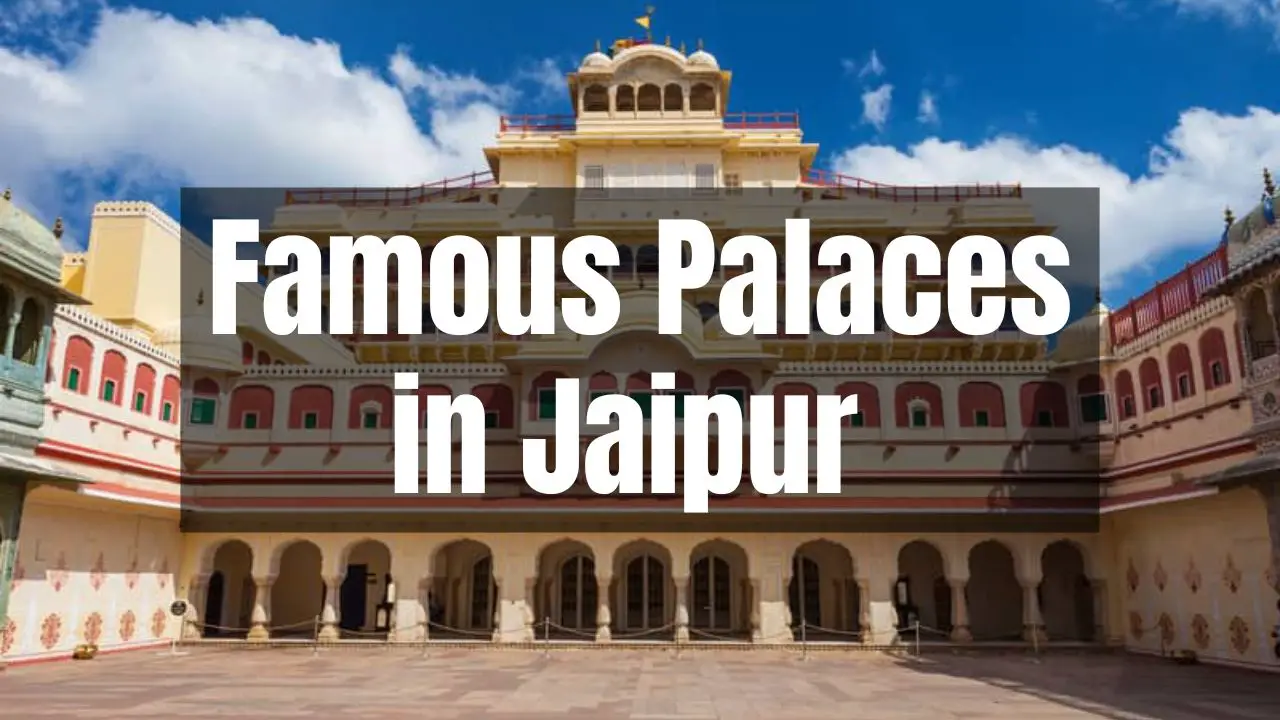Jaipur, the Pink City of India, is famous for its vibrant culture, rich history, and stunning architecture. The city is home to numerous palaces and forts that showcase the grandeur of the Rajput era. In this article, we’ll look at the ten most famous palaces in Jaipur that you must visit if you want to experience the royal heritage of Rajasthan. Let’s dive into the 10 most famous palaces in Jaipur!
10 Famous Palaces in Jaipur, Rajasthan
Forts and palaces in Jaipur attract tourists from around the world to bask in their heritage and beauty. With amazing palaces and architecture, Jaipur has become one of the cornerstones of the Golden Triangle in India – showcasing just how much people like to travel to the city!
Below are the ten must-visit royal palaces of yesteryear in Jaipur, Rajasthan. You can see the location of each palace and fort in the map below.
1. Rambagh Palace

The sprawling Rambagh Palace, situated 8 kilometers from Jaipur’s city center, occupies 47 acres of land. Originally built in 1835 as a garden house for King Ram Singh’s wet nurses, the house was later transformed into a grand palace by Maharaja Sawai Man Singh II. The renovation included the addition of several rooms and a royal suite for the Maharaja and his family. While it has been converted into a hotel, the palace retains its traditional Rajasthani ambiance.
The Rambagh Palace is a luxurious heritage hotel that was once the residence of the Maharaja of Jaipur. The palace was built in 1835, spreading over 47 acres of lush gardens. It has 79 rooms and suites, each exquisitely designed with traditional Rajasthani decor.
2. City Palace

The City Palace in Jaipur, is a prominent Jaipur landmark with a rich historical heritage. The palace gained significance when Sawai Man Singh moved here from his original residence, the Amber Palace, due to the acute water shortage it was facing.
Construction of the palace took place between 1729 and 1732, and its architectural style beautifully blends Rajasthani, Mughal, and European styles.
The City Palace is one of the most iconic landmarks of Jaipur. City Palace was built by Maharaja Sawai Jai Singh II during the 18th century and blends Rajasthani and Mughal architectural styles. The palace complex includes several buildings, courtyards, gardens, and the City Palace Museum (one of the best museums in Jaipur!) that offer a glimpse into the royal history of Jaipur.
3. Samode Palace

Situated 56 kilometers from Jaipur, Samode is one of Rajasthan’s largest towns and boasts a rich history. In the early 19th century, the town was transformed into a palace by King Rawal Berisal, who sought to create a grand residence reflecting the splendor of the Rajputana and Muslim architectural styles.
Today, the Samode Palace in Jaipur is a testament to the town’s royal legacy, with its grand courtyards, ornate frescoes, and intricate carvings. One of the palace’s most famous attractions is the Sheesh Mahal, or the Hall of Mirrors, renowned for its stunning reflective surfaces and detailed design.
The Samode Palace is a stunning example of Rajasthani architecture and design. It was built in the 16th century and has been converted into a heritage hotel. The palace features beautiful courtyards, intricate frescoes, and a stunning mirror-worked Sheesh Mahal.
4. Amer Palace

The Amer Fort in Jaipur also known as Amber Palace, is a stunning architectural wonder in the town of Amer, which was once ruled by the Meena dynasty. Originally built as a fort, the palace is a remarkable feat of engineering, carved entirely out of red sandstone and marble.
As one of Jaipur’s most popular tourist attractions, the palace is a stunning visual treat with its intricate carvings, beautiful archways, and magnificent courtyards. In addition, the palace compound also features the serene Maota Lake, adding to the picturesque setting of this historic site.
The Amer Palace, also known as the Amber Fort, is a UNESCO World Heritage Site and one of Jaipur’s most popular tourist attractions. It was built in the 16th century on a hill overlooking Maota Lake. The palace has several sections, including the Diwan-i-Aam, the Diwan-i-Khas, and the Sheesh Mahal.
5. Hari Mahal Palace

Built in 1930, the Hari Mahal Palace was once the residence of Rajadhiraj Hari Singh of Acrol, whose family dynasty can be traced back to Maharaja Prithviraj of Amer. Today, a portion of the palace has been converted into a heritage hotel, providing visitors with a glimpse into the lavish lifestyle of Rajasthan’s royalty.
While one half of the palace has been transformed into a hotel, the other half remains the residence of the surviving members of the dynasty. By staying in the heritage hotel, guests can experience the palace’s grandeur firsthand, marvel at its exquisite architecture, and immerse themselves in the region’s rich cultural heritage.
The Hari Mahal Palace was built in the early 20th century and is now a heritage hotel. The palace has 23 rooms and suites, each elegantly decorated with antique furniture and artwork. The palace also features a beautiful garden, a swimming pool, and a restaurant that serves delicious Rajasthani cuisine.
6. Rajmahal Palace
Constructed in 1729 as a symbol of love by Maharaja Sawai Jai Singh II for his beloved wife, the Rajmahal Palace has a rich and storied history. In 1821, the palace was repurposed as the residence of the British Resident Political Officer of the Rajputana Taluk. Throughout the years, the palace has welcomed many distinguished guests, including Queen Elizabeth II, the Shah of Iran, and Jackie Kennedy.
Today, the palace has been meticulously restored and transformed into a luxurious hotel open to the public. The palace’s magnificent decor still boasts relics from its illustrious past, including grand chandeliers and stunning marble staircases, offering visitors a glimpse into its rich cultural heritage.
The Rajmahal Palace is a luxury hotel that was once the residence of the Maharaja of Jaipur. The palace was built in the 18th century and has now been converted into a hotel that offers guests a luxurious and royal experience. The palace has 14 suites, each designed with a unique theme and decor.
7. Hawa Mahal

Maharaja Sawai Pratap Singh commissioned the construction of the Hawa Mahal in Jaipur in 1798. This five-story palace was designed to enable the women of the royal household to observe the daily activities of commoners. The palace’s intricate latticework on its numerous windows is a particular highlight of its design.
As the palace was built to allow for ample airflow, the constant gusts of wind blowing through its many windows earned it the name of the Hawa Mahal, meaning “Palace of the Winds.” The palace is open to visitors every day except for Fridays, providing ample opportunity to witness its remarkable architecture and design.
The Hawa Mahal, also known as the Palace of Winds, is an iconic landmark of Jaipur. It was built in 1799 and is a five-story structure with 953 small windows that allow the cool breeze to flow through the palace. The palace was created for the royal ladies to watch the processions on the street below without being seen.
8. Jal Mahal

A must-see attraction in Jaipur, the Jal Mahal is a breathtaking spectacle that will leave you spellbound. This magnificent palace rises tall from the center of the Man Sagar Lake, an architectural wonder that appears to float on the water’s surface.
While visitors are not permitted to access the interior of the palace in order to preserve its integrity, one can still enjoy a stroll along the walkways surrounding the structure. The palace’s surroundings are particularly enchanting during the evenings, offering picturesque vistas that are nothing short of magical.
The Jal Mahal, also known as the Water Palace, is located in the middle of Man Sagar Lake in Jaipur. The palace was built in the 18th century and is a five-story building, of which four stories are submerged in water. The palace is an architectural marvel and a popular spot for photography and sightseeing.
9. Narain Niwas Palace
Originally built by General Amar Singh, the Thakur of Kanota, the Narain Niwas Palace features strong influences from the Anglo-Indian style of Victorian-era architecture. Initially serving as a country resort for the Kanota dynasty, the palace now stands as a testament to Rajasthan’s rich cultural heritage.
Featuring opulent ethnic Indian furnishings and ornate wall decorations, the palace offers a glimpse into the extravagant lifestyle of Rajasthan’s royalty. Today, the palace has been transformed into a heritage hotel, allowing guests to experience the epitome of luxury living.
The Narain Niwas Palace is a heritage hotel built in the early 20th century. The palace has 37 rooms and suites, each decorated with a unique theme and style. The palace also features a beautiful garden, a swimming pool, and a restaurant that serves delicious Indian and international cuisine.
10. Shahpura Haveli
Constructed nearly 300 years ago in Shahpura, the Shahpura Palace originally functioned as a fortress providing a strategic vantage point. In the 18th century, under Rao Bishan Singh’s reign, the fort was transformed into a majestic palace.
Boasting a unique blend of Indo-Saracenic architectural styles, the palace has been repurposed as a heritage hotel. It has hosted various notable guests, including celebrities, artists, and royalty. The palace’s bougainvillea courtyards have become particularly renowned, adding to the grandeur and elegance of the hotel’s atmosphere.
The Shahpura Haveli is a beautiful heritage hotel built in the 18th century. The Haveli has now been converted into a hotel with 17 rooms and suites, each elegantly decorated with traditional Rajasthani furnishings. The Haveli also features a rooftop restaurant that offers stunning city views.
11. Patrika Gate (Bonus!)
Although not a palace or fort per se, the Patrika Gate in Jaipur gets an honorable mention on this list! Constructed in 2016, the gate is the ninth gate to be constructed in Jaipur and is one of the most instagrammable places in the entire city!
Covered from top to bottom in colorful paintings, the archways give a beautiful location for people to come and take photos. It is by far one of my most favorite places in the city, as it is less visited, and you can get absolutely stunning photos in the morning!
Key Takeaways: Explore the Beautiful Forts and Palaces of Jaipur
Jaipur is a city steeped in history and culture, and the palaces and havelis of the town are a testament to its royal heritage. If you are planning a Rajasthan tour, then these ten famous palaces offer a glimpse into the opulence and grandeur of the Rajput era. They are a must-visit for anyone who wants to experience the rich cultural history of Rajasthan.
Additionally, as you can see, many of the palaces and forts of Jaipur have been converted into resorts and heritage hotels. Rehabilitating these magnificent and famous palaces has helped preserve the historic architecture.
Jaipur is undoubtedly a beautiful place, offering magnificent buildings, culture, and heritage for tourists of all types. So, if you’re planning a trip to Jaipur, Rajasthan in India, make sure to visit these ten famous palaces for a trip you won’t forget!
If you want to expand your visit outside of Jaipur, then check out my blog covering the top 11 things to do in Rajasthan!
FAQs: 10 Most Famous Palaces in Jaipur
Below are some of the most frequently asked questions regarding the most famous palaces and forts in Jaipur, Rajasthan.
Jaipur has over 10 palaces and three forts and is beautiful, attracting tourists worldwide. Among the most famous are the Hawa Mahal, the Jaipur City Palace, the Amer Fort, and the Jaigarh Fort.
The best places to visit in Jaipur are:
1. Rambagh Palace
2. City Palace
3. Samode Palace
4. Amer Palace
5. Hari Mahal Palace
6. Rajmahal Palace
7. Hawa Mahal
8. Jal Mahal
9. Narain Niwas Palace
10. Shahpura Haveli
Jal Mahal is the most famous Mahal in Jaipur. It stands tall and majestic in the middle of the Man Sagar Lake and is the most famous structure in Jaipur.
Some of the other most well-known palaces in Jaipur include Rambagh Palace, City Palace, Samode Palace, Amber Palace, Hari Mahal Palace, Rajmahal Palace, and several others. The Pink City has a rich legacy of royalty, and members of the royal family still reside there.
The Jal Mahal, or Lake Palace, is a stunning sight in Jaipur, with its beautiful sand-colored stone walls contrasting against the deep blue water of the Man Sagar Lake. The palace, located in the lake’s center, appears to be floating and offers magnificent exteriors that visitors can admire. It is considered one of the most wonderful sights in Jaipur.
